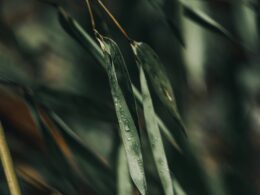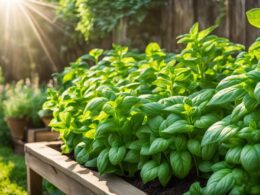Are you tired of your grass clippings piling up and creating a mess in your yard? Well, we have the solution for you! In this article, we will show you how to dry grass clippings effectively.
Drying grass clippings not only helps to reduce the amount of waste in your yard, but it also provides numerous benefits. By following these simple steps, you can turn your grass clippings into a valuable resource for your garden or landscaping projects.
We will guide you through the process of collecting and spreading the clippings, choosing the right location, and properly storing them. Additionally, we will explore some creative uses for dried grass clippings.
So, if you want to learn how to dry grass clippings safely and efficiently, keep reading!
Quick Summary
- Drying grass clippings reduces waste and provides benefits for your garden
- Grass clippings add organic matter and essential nutrients to the soil
- Dried grass clippings can be used as mulch to retain moisture and suppress weeds
- Properly storing dried grass clippings is important for preserving their quality
Benefits of Drying Grass Clippings
You can easily enhance your garden by drying grass clippings, which will transform into a fragrant, golden carpet of nutrients, ready to be spread and enrich the soil. Drying grass clippings not only helps to reduce waste but also provides numerous benefits for your garden.
One of the main advantages of using grass clippings as compost is that it adds organic matter to the soil, improving its structure and fertility. As the clippings decompose, they release essential nutrients like nitrogen, phosphorus, and potassium, which are vital for healthy plant growth.
Another benefit of drying grass clippings is that they can be used as mulch. Mulching with dried grass clippings helps to retain moisture in the soil, suppress weed growth, and regulate soil temperature. It acts as a protective layer, preventing soil erosion and reducing the need for frequent watering. Additionally, dried grass clippings can act as a natural weed barrier, preventing weed seeds from germinating and competing with your plants for nutrients.
To dry grass clippings, simply spread them out in a thin layer and let them dry in the sun. Make sure to turn them regularly to ensure even drying. Once they are completely dry, you can store them in bags or bins until you’re ready to use them. Remember to wear gloves and protective clothing when handling dried grass clippings to avoid any potential irritation.
By drying grass clippings and using them as compost or mulch, you can improve the health and productivity of your garden while reducing waste. It’s a simple and effective way to create a sustainable and beautiful garden environment.
Collect and Spread Grass Clippings to Dry
Spread the freshly cut grass all over your lawn to let it air out and become crisp. This is an important step in the process of drying grass clippings.
Here are four things to keep in mind when collecting and spreading your grass clippings:
-
Safety first: Make sure to wear gloves and closed-toe shoes when handling grass clippings to protect yourself from any sharp objects or potential allergens.
-
Benefits of composting grass clippings: Drying grass clippings can be the first step towards composting them. Composting grass clippings adds valuable nutrients back into the soil, improves soil structure, and reduces the need for artificial fertilizers.
-
Ways to reuse dried grass clippings: Once the grass clippings are dry, there are several ways to reuse them. You can use them as mulch in your garden to help retain moisture, suppress weeds, and regulate soil temperature. They can also be added to your compost pile to provide a carbon-rich ‘brown’ material.
-
Avoid overloading: It’s important not to spread too thick of a layer of grass clippings, as this can prevent proper drying and lead to a smelly and slimy mess. Aim for a thin layer that allows air to circulate and promotes even drying.
By following these tips, you can safely and effectively collect and spread your grass clippings to dry, benefiting both your lawn and the environment.
Choose a Dry and Sunny Location
Find a sunny spot in your yard where the sun’s rays can help speed up the drying process. When it comes to drying grass clippings, choosing the right location is crucial. You want to create ideal drying conditions while also preventing moisture buildup.
First and foremost, find a spot that gets plenty of direct sunlight throughout the day. The sun’s rays will not only help evaporate any moisture in the grass clippings but also prevent any new moisture from accumulating. This is important because moisture can lead to mold and other unwanted issues.
Additionally, make sure the chosen spot is well-ventilated. This will allow for better air circulation, which aids in the drying process. Avoid areas that are prone to high humidity or are shaded, as these can hinder the drying process.
It’s also important to spread the grass clippings out thinly and evenly in the chosen location. This will allow for maximum exposure to the sun and air, ensuring that the clippings dry quickly and evenly.
By selecting a dry and sunny location for drying your grass clippings, you’ll be able to achieve optimal drying conditions while minimizing the potential for moisture buildup. Remember to regularly check the clippings and turn them over to ensure even drying. With a little patience and the right location, you’ll have perfectly dried grass clippings in no time!
Spread Grass Clippings Thinly and Evenly
Imagine a vibrant, sun-kissed landscape where thin, even layers of freshly cut green are laid out, basking in the warm rays of the sun. To effectively dry grass clippings, it’s crucial to spread them thinly and evenly. By doing so, you allow maximum exposure to sunlight and air circulation, ensuring a safe and efficient drying process.
Here are the key steps to spread grass clippings thinly and evenly for optimal drying:
-
Even Distribution: Spread the grass clippings evenly over the drying area. This helps to prevent clumping and allows for uniform drying.
-
Avoid Piling: Resist the temptation to pile up the clippings. Thick layers can hinder proper airflow and slow down the drying process. Remember, safety comes first!
-
Regular Turning: Periodically turn the clippings to promote even drying. This helps to prevent mold or rot from developing and ensures that the clippings dry uniformly.
Drying grass clippings offers numerous benefits. Firstly, it reduces the moisture content, which helps prevent the growth of bacteria and fungi. Secondly, dried grass clippings make excellent mulch, enriching the soil with nutrients as they decompose. Lastly, by drying and using the clippings as mulch, you minimize waste and contribute to a healthier, sustainable environment.
So, spread those clippings thinly and evenly, and enjoy the benefits of drying!
Turn and Mix Grass Clippings Regularly
To ensure optimal drying and prevent the growth of mold or rot, regularly turning and mixing the freshly cut green is essential. Mixing techniques play a crucial role in speeding up the drying process and ensuring that the grass clippings dry evenly. By turning and mixing the clippings, you allow air to circulate and moisture to escape, reducing the risk of mold or rot.
When it comes to mixing grass clippings, there are a few techniques you can use. One method is to use a pitchfork or rake to turn the clippings regularly. This helps to break up any clumps and allows the clippings to dry more quickly. Another technique is to layer the clippings thinly, alternating with dry materials like leaves or straw. This promotes faster drying and prevents clumping. Lastly, you can use a compost tumbler or bin to mix the clippings. This method allows for easy turning and mixing, ensuring that the clippings dry evenly.
By incorporating these mixing techniques into your drying process, you can ensure that your grass clippings dry thoroughly and safely. Remember to wear appropriate safety gear, such as gloves and a mask, when handling the clippings. Safety should always be a priority when working with organic materials.
Can Thinning Grass Help Prevent Excessive Grass Clippings?
Thinning overgrown grass effectively can indeed help prevent excessive grass clippings. By trimming the grass down to an appropriate height, clippings become more manageable. Thinning the grass promotes better airflow and sunlight penetration, thus reducing the likelihood of excessive clippings. This method ensures a healthier lawn and makes mowing easier and more efficient.
Monitor and Adjust Drying Time
Keep a close eye on the drying process and make sure to adjust the time accordingly, ensuring that the moisture content is just right for optimal results. Monitoring and adjusting the drying time is crucial to ensure that your grass clippings are dried properly and safely.
Here are three key points to consider when adjusting the drying time:
-
Safety first: It’s important to monitor the drying process to prevent any potential hazards. Wet grass clippings can create heat and lead to spontaneous combustion, causing a fire. By regularly checking the moisture content and adjusting the drying time, you can minimize the risk of fire.
-
Optimal moisture level: The ideal moisture content for dried grass clippings is around 10%. This level ensures that the clippings are dry enough to store without rotting or developing mold. Use a moisture meter or simply feel the grass clippings to determine if they’re adequately dried.
-
Adjusting the drying time: Factors such as weather conditions, humidity levels, and the thickness of the grass clippings can affect the drying time. If the clippings aren’t drying as quickly as desired, you may need to extend the drying time. On the other hand, if they’re drying too quickly, you can shorten the drying time to avoid over-drying.
By closely monitoring and adjusting the drying time, you can achieve perfectly dried grass clippings that are safe to store and use for various purposes. Remember to prioritize safety throughout the process to prevent any potential risks.
Store Dried Grass Clippings Properly
Properly storing dried grass clippings is essential for preserving their quality and maximizing their usefulness. After you’ve successfully dried your grass clippings, it’s important to store them correctly to ensure they remain dry and free from moisture.
There are a few effective storing techniques you can employ to achieve this.
Firstly, make sure to store your dried grass clippings in a dry and well-ventilated area. Avoid storing them in a damp or humid environment, as this can lead to the growth of mold or mildew. It’s also crucial to keep them away from any direct sunlight, as prolonged exposure can cause them to lose their color and nutritional value.
Secondly, consider using airtight containers or bags to store your dried grass clippings. These can help prevent moisture from seeping in and spoiling the clippings. Be sure to label the containers with the date of storage to keep track of their freshness.
Lastly, regularly check on your stored grass clippings and inspect for any signs of moisture or spoilage. If you notice any, remove the affected clippings immediately to prevent further damage.
By following these storing techniques and actively preventing moisture, you can ensure that your dried grass clippings remain in excellent condition for future use. Remember, proper storage is key to maintaining their quality and maximizing their benefits.
Creative Uses for Dried Grass Clippings
Storing dried grass clippings correctly is essential, but once you have them, get ready to discover some fun and creative ways to use them! Here are three exciting uses for your dried grass clippings that will surely spark your creativity and enhance your gardening experience:
-
Mulching Magic: Spread a layer of dried grass clippings around your plants to create a natural mulch. It doesn’t just help retain moisture in the soil, but it also acts as a weed barrier, preventing unwanted growth. Plus, it adds a beautiful touch to your garden beds!
-
Composting Brilliance: Mix your dried grass clippings with other organic matter, like kitchen scraps and leaves, to create nutrient-rich compost. This natural fertilizer will nourish your plants and promote healthy growth. Remember to turn the compost regularly for optimal decomposition.
-
Eco-friendly Pathways: Create unique and eco-friendly pathways in your garden by using dried grass clippings. Simply layer them on the ground to form a soft and natural walking surface. It not only adds a rustic charm to your garden, but it also helps reduce soil erosion.
These creative gardening ideas allow you to make the most out of your dried grass clippings while promoting sustainability and safety in your garden. So go ahead and explore these exciting uses – your garden will thank you!
Frequently Asked Questions
Can I dry grass clippings indoors?
Yes, you can dry grass clippings indoors. Indoor drying methods like air drying or using a dehydrator can help preserve nutrients. It’s a safe option that prevents mold growth and allows you to control the drying process.
Can I use a lawnmower bag to collect grass clippings for drying?
Yes, you can use a lawnmower bag to collect grass clippings for drying. However, it’s safer to use a rake to collect the clippings and then spread them out on a tarp to dry thoroughly.
How long does it take for grass clippings to dry completely?
To speed up the drying process of grass clippings, spread them out in a thin layer and turn them regularly. Ensure they are completely dry before storing them in a cool, dry place.
Can I use a leaf blower to spread grass clippings for drying?
To safely dry grass clippings without a leaf blower, try alternative methods like raking them into thin layers, using a compost pile, or spreading them on a tarp. These methods are effective and prevent accidents.
Can I use dried grass clippings as mulch in my vegetable garden?
Yes, you can use dried grass clippings as mulch in your vegetable garden. It acts as a natural fertilizer, enriching the soil with nutrients and helping to retain moisture. This method has several benefits and is safe for your plants.
Conclusion
In conclusion, drying grass clippings is a simple and beneficial process. By collecting and spreading the clippings in a dry and sunny location, and regularly turning and mixing them, you can ensure they dry thoroughly.
Monitoring and adjusting the drying time is important to avoid over-drying or moisture retention. Once dried, store the clippings properly to maintain their quality.
And don’t forget, there are many creative uses for dried grass clippings, such as composting or using them as mulch in your garden. So go ahead and start drying those clippings for a greener and healthier lawn!








